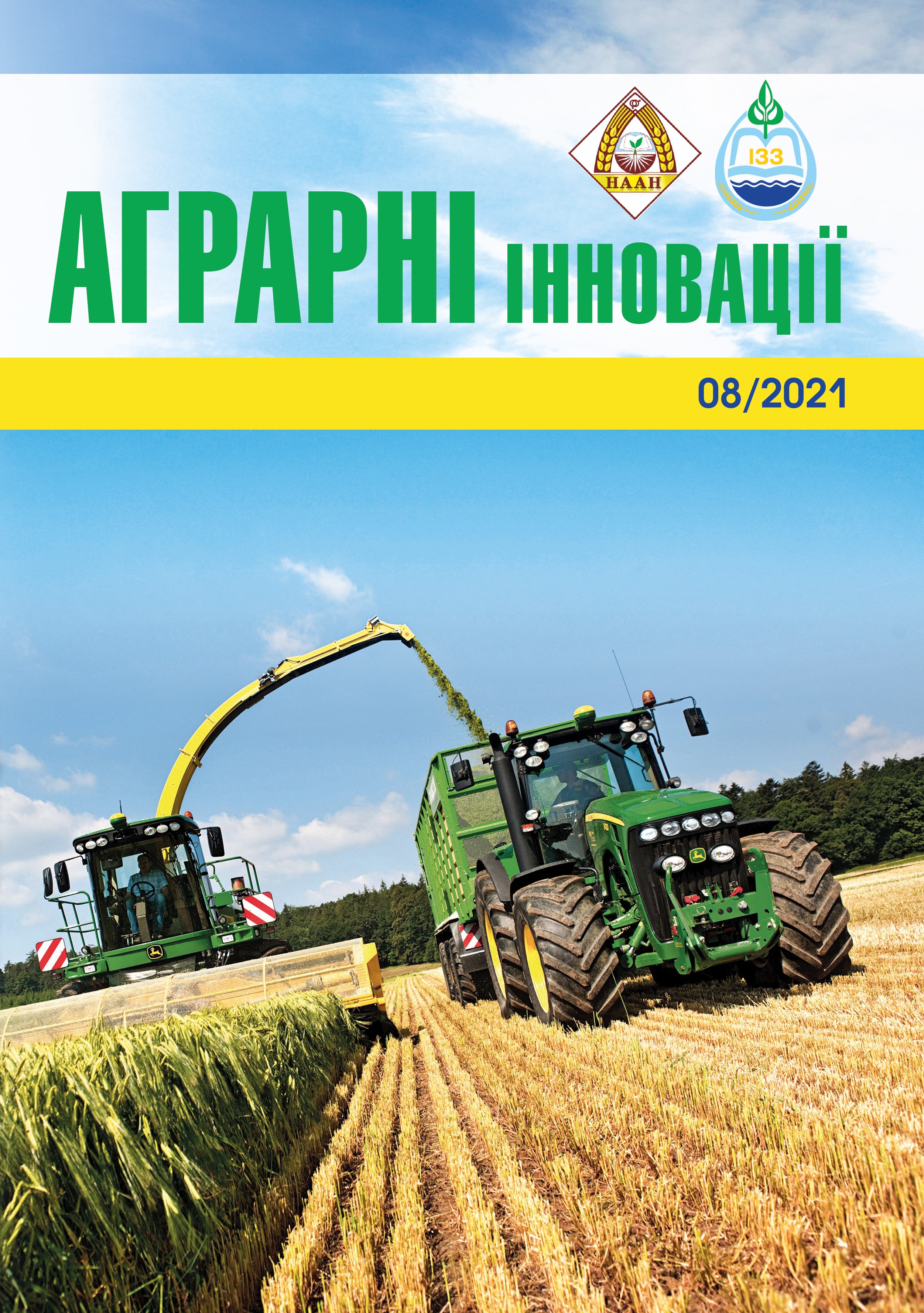Dynamics of leaf surface formation of grass pea and productivity of its photosynthetic activity depending on the level of mineral nutrition
Abstract
Purpose – to find out the effect of different mineral fertilizers doses, pre-sowing seed treatment with microbiological preparation on the basis of nitrogen-fixing microorganisms and foliar fertilization with micronutrients on the dynamics of leaf surface formation, sowing duration and photosynthetic productivity. Methods. The researches were conducted at the experimental field of the State Research Enterprise «EF «Stepne» of the Institute of Pig Breeding and AIР NAAS» of Poltava district of Poltava region during 2018-2020 years. The following elements of cultivation technology were studied: application of mineral fertilizers in doses N20P40K40, N40P40K40, pre-sowing seed inoculation with a complex of microbiological preparation Rhizoline (3,0 l/t) and bioprotector Rhizosave (1,0 l/t), its combination with foliar fertilization in phase of branching with microfertilizer Avangard R Bobovi (2,0 l/ha) and complex application of inoculant and bioprotector with macro- and microfertilizers. Research results indicate a significant positive effect of studied agro-technological techniques on the plant leaf surface formation dynamics and its active photosynthetic work duration. The most favorable conditions for the assimilation apparatus functioning, which was expressed in the accumulation of plants a significant amount of organic aboveground biomass were created by a combination of presowing seed treatment, foliar fertilization and mineral fertilizer application at the dose N20Р40К40. Accordingly, in this variant, the grain productivity of crops was the highest – 3,07 t/ha. The grain yields in the variants with mineral fertilizer application at the doses N20Р40К40 and N40Р40К40 were 2,80 and 2,93 t/ha, respectively, which exceeded the control by 20,3 and 23,9 %. Carrying out pre-sowing seed inoculation and its combination with foliar application of plants made it possible to increase the grain productivity of crops to 2,44 and 2,57 t/ha, respectively. Conclusion. The size of plant photosynthetic apparatus, duration and productivity of its active functioning were due to the improvement of plant nutrition due to the introduction into the rhizosphere of a microbiological preparation based on nitrogen-fixing microorganisms and their provision with available forms of mineral nutrients. The combination of pre-sowing seed inoculation, foliar fertilization of plants and application of mineral fertilizers in a dose N40P40K40, was most expedient, where due to prolongation of the period of productive photosynthetic activity of well-developed assimilation surface in conditions of insufficient moisture the grain productivity increased to 3.07 t/ha.
References
2. Силенко C. І., Єремко Л. С., Силенко О. С., Роговий О. Ю., Андрущенко О. В., Гангур В. В. Добір вихідного матеріалу чини посівної (Lathirus sativus L.) для створення посухостійких сортів. Вісник ПДАА. 2020. № 3. С. 99–108. URL: https://doi.org/10.31210/visnyk2020.03.1.
3. Al-Snafi A. E. Chemical Constituents and Pharmacological Effects of Lathyrus Sativus – A Review. IOSR Journal of Pharmacy (IOSRPHR). 2019. Vol. 9. P. 51–58.
4. Hailu D., Abera S., Teka T. A. Effects of processing on nutritional composition and anti-nutritional factors of grass pea (Lathyrus Sativus L): A Review. Food Science and Quality Management. 2015. Vol. 36. Р. 61–71.
5. Lambein F., Travella S., Kuo Y. H., Montagu M. V., Marc Heijde. Grass pea (Lathyrus sativus L.): orphan crop, nutraceutical or just plain food? Planta. 2019. Vol. 250. P. 821–838. URL: https://doi.org/10.1007/s00425-018-03084-0.
6. Kumar S., Bejiga G., Ahmed S., Nakkoul H., Sarker A. Genetic improvement of grass pea for low neurotoxin (β-ODAP) content. Food and Chemical Toxicology. 2011. Vol. 49. P. 589–600. URL: https://doi.org/10.1016 / j.fct.2010.06.051.
7. Mehmet A. Fatty acid characteristics of grass pea (Lathyrus sativus) in an East Mediterranean environment. Cogent Chemistry. 2017. Vol. 3. Р. 1–9. URL: https://doi.org/10.1080/23312009.2017.1296748.
8. Khandare A. L., Kumar R. H., Meshram I. I., Arlappa N., Laxmaiah A., Venkaiah K., Rao P. A., Validandi V., Toteja G. S. Current scenario of consumption of Lathyrus sativus and lathyrism in three districts of Chhattisgarh State, India. Toxicon. 2018. Vol. 150. P. 228–234. URL: https://doi.org/10.1016 / j.toxicon.2018.06.069.
9. Rybiński W., Karamać M., Sulewska K., Börner A., Amarowicz R. Antioxidant potential of grass pea seeds from European countries. Foods. 2018. Vol. 7. Р. 142–153. URL: https://doi.org/10.3390/foods7090142.
10. Ничипорович А. А. О путях повышения продуктивности фотосинтеза растений в посевах. Фотосинтез и вопросы продуктивности растений. Москва : Изд-во АН СССР, 1963. С. 5–36.
11. Tokarz K. M., Wesołowski W., Tokarz B., Makowski W., Wysocka A., Jedrzejczyk R. J., Chrabaszcz K., Malek K., Kostecka-Gugała A. Stem photosynthesis – a key element of grass pea (Lathyrus sativus L.) acclimatisation to salinity. International Journal of Molecular Sciences. 2021. Vol. 22. P. 685–718. URL: https://doi.org/10.3390/ijms22020685.
12. Єремко Л. С., Швець А. Ю., Кобилинський І. В., Саєнко В. О. Оптимізація поживного режиму – фактор підвищення продуктивності посівів чини посівної (Lathirus sativus L.). Вісник ПДАА. 2021. № 1. С. 149–155. URL: https://doi.org/10.31210/visnyk2021.01.18.
13. Єремко Л. С., Гангур В. В., Киричок О. О., Сокирко Д. П. Мінеральне живлення як фактор підвищення фотосинтетичної продуктивності і урожайності посівів гороху. Вісник ПДАА. 2019. № 3. С. 50−56. URL: https://doi.org/10.31210/visnyk2019.03.06.
14. Сокирко Д. П., Гангур В. В., Єремко Л. С. Вплив елементів технології вирощування на формування симбіотичного апарату зернобобових культур. Colloquium-journal. 2021. № 10 (97). P. 30–32.
15. Li X., Zen R., Liao H. Improving crop nutrient efficiency through root architecture modification. Journal of Integrative Plant Biology. 2016. Vol. 58. Р. 193–202. URL: https://doi.org/10.1111/jipb.12434.
16. Mart´inez-Ballesta M. C., Dominguez-Perles R., Moreno D. A., Muries B., Alcaraz-Lopez C., Bast´ias E., Garc´ia-Viguera C., Carvaja M. Minerals in plant food: effect of agricultural practices and role in human health. A review. Agronomy for Sustainable Development. 2010. Vol. 30. P. 295–309.
17. Попов В. В. Содержание микроэлементов в почвах юго-востока Ростовской области. Агрохимический вестник. 2002. № 3. С. 37–38.
18. Ничипорович А. А., Строганова Л. Э., Чмора С. Н., Власова М. П. Фотосинтетическая деятельность растений в посевах. Москва : Издательство АН СССР, 1961. 133 с.
19. Ничипорович А. А. Фотосинтетическая деятельность растений и пути повышения их продуктивности. Теоретические основы фотосинтетической продуктивности. Москва : Наука, 1972. 527 c.
20. Кошкин Е. И. Частная физиология полевых культур. Учеб. пособ. Москва : Колос, 2005. 344 с.






